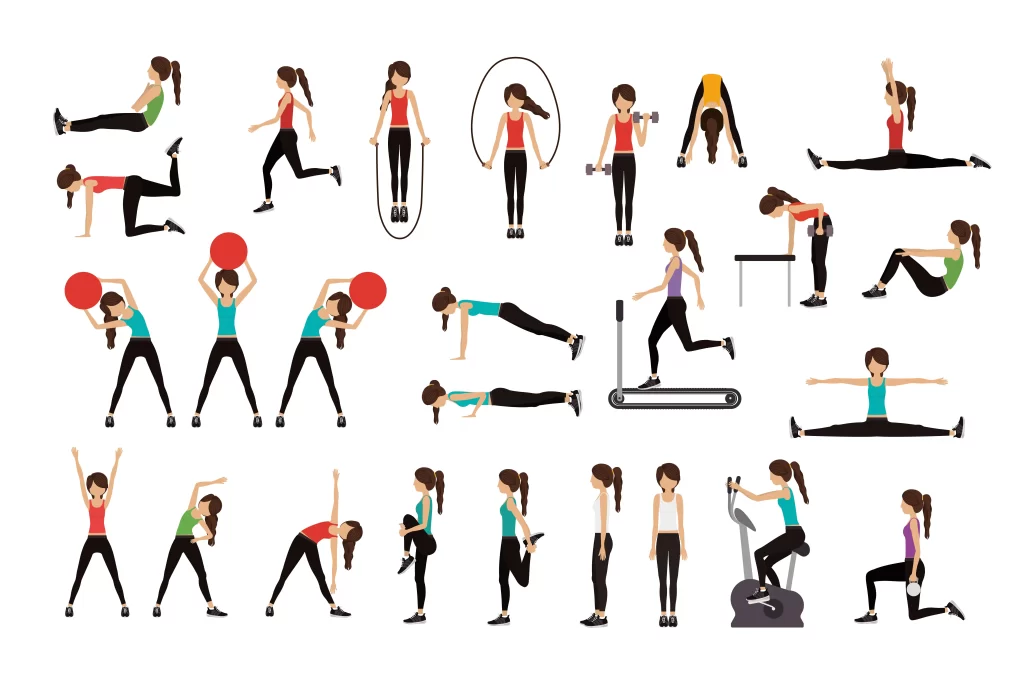Remember, it’s about being well when exercising to manage your weight. I will guide you through ten best weight management through exercise strategies. They help with weight loss and make your life healthier and more fulfilling. So, tighten your shoelaces and dive into fitness and well-being together.
1 Understanding the Basics of Weight Management
Managing your weight is different for everyone. It’s about finding what works for you. Exercise is essential for our body. It helps us burn calories and improves how our body works. When you understand the basics, you prepare for a successful journey to manage your weight.
To effectively manage weight, it’s essential to know that it’s about losing weight and maintaining a healthy balance. Regular exercise plays a pivotal role in achieving this equilibrium. When we engage in physical activity, our bodies burn calories, leading to weight loss. Additionally, exercise boosts metabolism, improves cardiovascular health, and enhances overall well-being.
2 Setting Realistic Goals
Starting a weight loss journey without specific, reachable goals is like sailing without a destination. Plans provide direction and purpose, guiding your efforts toward success. When it comes to exercise, setting realistic objectives is crucial. Unrealistic goals can lead to frustration and burnout, derailing your progress.
Start by establishing achievable short-term and long-term goals. For short-term goals, you could commit to several workouts per week. Meanwhile, aim to reach a specific weight or fitness level for long-term purposes. By breaking down your journey into manageable steps, you create a roadmap to success.

3 Types of Exercises for Weight Management
Exercise is not a one-dimensional activity; there are various types, each offering unique benefits. Knowing the difference between aerobic and anaerobic exercises is essential when planning a workout.
Exercises like running, cycling, and swimming raise heart rate and oxygen levels. These activities are excellent for burning calories and improving cardiovascular health. In contrast, anaerobic exercises, such as weight lifting and high-intensity interval training (HIIT), aim to increase strength and muscle.
To manage your weight effectively, include aerobic and anaerobic exercises. During cardiovascular workouts, you burn calories. Strength training helps with long-term weight loss because it builds muscle, which speeds up metabolism.

4 Creating a Balanced Exercise Routine
Balance is the key to a sustainable and effective exercise routine. Do different exercises for your heart, muscles, and flexibility to have a good plan.
Cardiovascular exercises increase your heart rate and burn calories. These can include brisk walking, jogging, or using cardio machines at the gym. Using weights or resistance bands in strength training helps build muscles and boost metabolism. Flexibility exercises, like yoga or stretching, enhance overall mobility and prevent injuries.
The combination of these elements not only accelerates weight loss but also promotes overall health. A balanced routine ensures that all aspects of fitness are addressed, creating a holistic approach to weight management.

5 High-Intensity Interval Training (HIIT)
If you want a fast and efficient workout, try High-Intensity Interval Training (HIIT). It can make a big difference. HIIT is a type of workout involving intense exercises and then taking breaks or doing less severe activities.
This method burns calories during exercise and activates the afterburn effect known as EPOC. This means your body continues to burn calories at a high rate even after exercising.
Adding HIIT to your routine makes your workouts more effective for weight loss. It adds a dynamic and challenging element.

6 Incorporating Strength Training
Contrary to common misconceptions, strength training is not reserved for bodybuilders. It is a crucial component of any effective weight management plan. Strength training helps build lean muscle mass, improving appearance and aiding in weight loss.
Muscles burn more calories at rest than fat tissue, so the more muscle mass you have, the higher your resting metabolic rate. This means you’ll continue burning calories even when you’re not exercising. Doing strength training exercises two or three times a week can help you manage your weight better.

7 Understanding the Role of Diet
Exercise and diet go hand in hand regarding effective weight management. You can only out-exercise a good diet; conversely, proper nutrition enhances the impact of your workouts.
Eating a mix of healthy foods like fruits, veggies, lean proteins, and whole grains gives you energy for exercise. Proper nutrition supports your body’s recovery and gives you the power to perform at your best during training.
Moreover, staying hydrated is crucial. Water is essential for various bodily functions, including metabolism and digestion. Staying hydrated helps your health and can help you lose weight by stopping overeating because sometimes you think you’re hungry when you’re thirsty.

8 Consistency is Key
In the realm of weight management, consistency is your greatest ally. Regular and consistent exercise is more effective than sporadic, intense workouts. It’s better to establish a routine you can maintain over the long term rather than pushing yourself to the limit for a short period.
Consistency not only helps with weight loss but also creates lasting habits. Making exercise a regular part of your routine contributes to overall health and well-being. Find activities you enjoy, whether a daily walk, a dance class, or a gym workout, and make them a consistent part of your schedule.
9 Monitoring Progress
Numbers can be powerful motivators on your weight management journey. By keeping track of how you’re doing, you can learn much about whether your exercise routine works well for you. This can help you make any changes you need to.
You can track weight, body measurements, and fitness milestones to celebrate achievements and find improvement areas. However, it’s essential to approach these metrics with a healthy mindset. The scale is just one measure of progress; changes in muscle mass and overall well-being are equally important.
Consider keeping a workout journal or using fitness apps to log your activities and monitor your progress. This enhances your accountability and serves as a source of motivation as you witness your achievements.
10 Adapting to Individual Needs
Recognizing that one size doesn’t fit all is crucial on your weight management journey. What works for someone else might not work for you, and that’s perfectly normal. Embrace discovering what activities you enjoy and what fits into your lifestyle.
You’ll be more consistent with your exercise if you like swimming, cycling, weightlifting, or yoga. The key is to make it a lifestyle rather than a temporary effort. Try different activities until you find what works for you and matches your goals.
Conclusion
Embarking on a weight management journey through exercise is a commitment to a healthier, happier you. You need to know effective strategies, set realistic goals, and stay balanced to succeed. Remember, it’s not just about the destination but the journey itself. Stay consistent, celebrate your achievements, and enjoy the transformative process of becoming the best version of yourself.
FAQs
How long should I exercise each day for effective weight management?
Aim for at least 150 minutes of moderate-intensity weekly exercise distributed across several days.
Can I solely rely on exercise for weight loss, or is diet more crucial?
Both exercise and diet play crucial roles. While activity contributes to weight loss, a balanced diet is equally important for overall health.
Is it necessary to consult a doctor before starting a new exercise routine?
Yes, especially if you have pre-existing health conditions. Consultation ensures your exercise plan aligns with your health needs.
What role does sleep play in weight management through exercise?
Quality sleep is crucial. Lack of sleep can hinder weight loss efforts and affect overall well-being.
How do I stay motivated when I don’t feel like exercising?
Find activities you enjoy, set achievable goals, and consider exercising with a friend for added motivation. Consistency is critical, and every small effort contributes to your overall progress.

